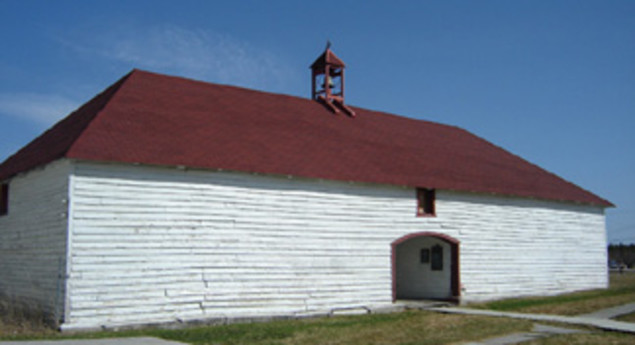DESCRIPTION OF HISTORIC PLACE
Norway House National Historic Site of Canada consists of the remnants of the former Hudson’s Bay Company fort at Norway House, Manitoba. The three wooden buildings, the Archway Warehouse, Gaol and Powder Magazine, sit in the stark landscape, near the banks of the Nelson River, at the north end of Lake Winnipeg. Official recognition refers to the individual buildings on their footprints.
HERITAGE VALUE
Norway House was designated a national historic site of Canada in 1954 for the following reasons:
- it was a convenient meeting place for the Council of the Northern Department of Rupert’s Land and an important trading post; and,
- in 1875, Treaty No. 5 was made here.
The heritage value of Norway House lies primarily in its historical associations as the Hudson’s Bay Company’s principal inland depot for the fur trade. It is also the place where Treaty No. 5 was made between the Saulteaux (Ojibwa), the Swampy Cree First Nations people and the Crown in 1875. It was also the site where the Rev. James Evans invented the Cree Syllabic System. Norway House was established on this site in 1825-26. Surviving buildings including the Archway Warehouse (1839-1841), the Gaol (1855-1856), and the Powder Magazine (1837-1838) bear witness to this history.
Sources: Historic Sites and Monuments Board of Canada, Minutes, June 1954; Plaque Text, 1937.
CHARACTER-DEFINING ELEMENTS
Key elements contributing to the heritage value of this site include:
- the location of the fort on the Nelson River between Lake Winnipeg and James Bay;
- the siting and interrelationship of the buildings within the fort;
- the predominant use of locally available building materials and techniques.
Key elements contributing to the heritage value of the Archway Warehouse include:
- its rectangular massing under a hipped roof;
- its Red River Frame construction with plank facing;
- its symmetrically organized façade with central round-headed doors and interior passage, small loft window, and bell tower;
- its bellturret, which serves as a landmark from the water;
- its balanced articulation of windows on the lee side;
- its surviving original interior subdivision and whitewash finish;
- surviving original iron bars, sheathing, and hardware;
- its dominant siting within the complex, with one façade along the river.
Key elements contributing to the heritage value of the Gaol include:
- its rectangular massing under a hipped roof;
- its symmetrically organized façade with its central door;
- its superbly crafted rubblestone masonry construction with cut limestone quoins and lintels;
- the thick granite walls, iron-sheathed door, window bars, and sparse use of apertures that speak of its function;
- the date “1855" chiseled above the doorway;
- the siting of the Gaol in a secondary position on the south perimeter of the early fort’s interior compound.
Key elements contributing to the heritage value of the Powder magazine include:
- its original footprint and massing;
- its rubblestone construction materials;
- its siting on a point of land remote from the original fort.
Earn 10 points!
Photo: http://www.visitnorthernmanitoba.ca/index.phppageid=COMDET&communityid=NORWAYMB









